Note:
I use chicken wire instead of hardware cloth. Some people may critique that, but I don't have a ton of predators around here, and those that we do have are content to hunt rodents in nearby fields. I have never had a predator rip the wire, and don't believe one ever will.
You can use hardware cloth on your run instead of chicken wire, or just use chicken wire. Your coop belongs to you, and decisions are yours to make.
Think what you like, but please, don't start an argument. We are all united in the fact that we want to keep our poultry safe, let's keep it that way.
We built this run for multiple reasons. The main one was because whenever we went on vacations, my chickens were locked in their coops full time. Another reason was because when I had multiple coops, I had to shut both coops at night (and open them in the morning), and give them separate feed and water systems. (At the time I had two coops: The Triangle Coop and The Tall Coop)
The solution was to make a way for the chickens to stretch their wings and to connect the coops while still keeping the chickens safe from predators.
A walk-in run would take up too much space and supplies, so we settled for a short, but long and wide, run.
We started the construction of the run in the garage (year 2015). I don't have any pictures of the building process, or any record of the time it took, but I'll try to explain the best I can.
The run starts with a wooden frame. There is no particular order in the board placement, just a wooden outline and a few support beams. Hopefully the pictures will explain.

Overall view.
 I
I
View of main run from the door.

View of main run from the back.
We installed two exterior wood doors and left gaps where the coops would attach.

Main run door, held shut by a log.
Then we double-wrapped it all in chicken wire; top, bottom, and all so that predators can't dig in. Some people say that chicken wire won't keep the predators out, but I have had no problems with it. However, predators are not very "feisty" in my area and I try to always use a double-wrap of wire for good measure. But if it makes you feel safer you could use some other type of wire.
Lastly, we moved the run out to the chicken yard. I don't remember exactly how we did this, just that it was hard. Advice for future builders: try to build near your coop and not on the other side of your property!!!
If needed, I can separate the coops by blocking them off from the run. Sometimes I do this for integration purposes.
The only type of poultry I keep (well, excluding pigeons) are chickens, but I believe this run would also work for ducks, geese, turkeys, quail, peacocks, and more. You just might need to make size adjustments.
For the sake of clarification, let's call this run the "main run" from now on.
Rounding to the nearest foot, my main run is six by nine feet. The height is about 1 1/2 feet. I think it is a nice size, though I wouldn't mind it being a bit taller.
In 2019 we built a new coop with a private run attatched. This run is very similar to my main run, except that it is a bit taller and instead of the bottom being wrapped in wire, we dug down about a foot and made a vertical wire skirt.
The cool thing is, we attached the private run to the main run by way of the main run's extra exterior door. This makes it so we can merge the runs at will!

The door that separates the main and private runs.
For more about the private run, explore The Chick Coop!
The pros and cons to having a short, predator-proof run:
Pros
Cons
My runs are simple, but ever useful. I think everybody should have one! Best of luck!
P.S. If you want to see more of my builds, check out this link: SoftSilkie's Farmyard
I use chicken wire instead of hardware cloth. Some people may critique that, but I don't have a ton of predators around here, and those that we do have are content to hunt rodents in nearby fields. I have never had a predator rip the wire, and don't believe one ever will.
You can use hardware cloth on your run instead of chicken wire, or just use chicken wire. Your coop belongs to you, and decisions are yours to make.
Think what you like, but please, don't start an argument. We are all united in the fact that we want to keep our poultry safe, let's keep it that way.
We built this run for multiple reasons. The main one was because whenever we went on vacations, my chickens were locked in their coops full time. Another reason was because when I had multiple coops, I had to shut both coops at night (and open them in the morning), and give them separate feed and water systems. (At the time I had two coops: The Triangle Coop and The Tall Coop)
The solution was to make a way for the chickens to stretch their wings and to connect the coops while still keeping the chickens safe from predators.
A walk-in run would take up too much space and supplies, so we settled for a short, but long and wide, run.
We started the construction of the run in the garage (year 2015). I don't have any pictures of the building process, or any record of the time it took, but I'll try to explain the best I can.
The run starts with a wooden frame. There is no particular order in the board placement, just a wooden outline and a few support beams. Hopefully the pictures will explain.
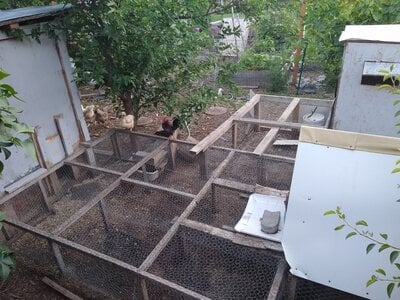
Overall view.
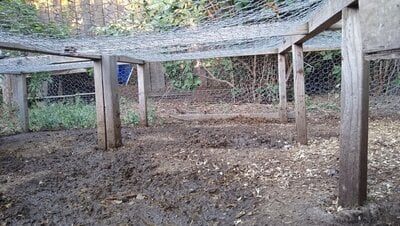 I
IView of main run from the door.
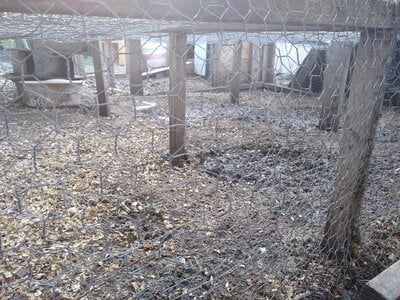
View of main run from the back.
We installed two exterior wood doors and left gaps where the coops would attach.
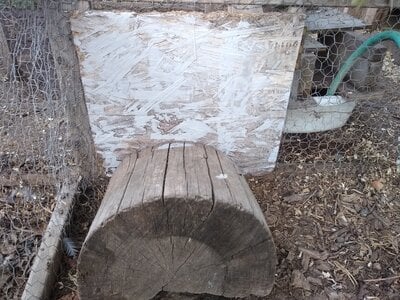
Main run door, held shut by a log.
Then we double-wrapped it all in chicken wire; top, bottom, and all so that predators can't dig in. Some people say that chicken wire won't keep the predators out, but I have had no problems with it. However, predators are not very "feisty" in my area and I try to always use a double-wrap of wire for good measure. But if it makes you feel safer you could use some other type of wire.
Lastly, we moved the run out to the chicken yard. I don't remember exactly how we did this, just that it was hard. Advice for future builders: try to build near your coop and not on the other side of your property!!!
If needed, I can separate the coops by blocking them off from the run. Sometimes I do this for integration purposes.
The only type of poultry I keep (well, excluding pigeons) are chickens, but I believe this run would also work for ducks, geese, turkeys, quail, peacocks, and more. You just might need to make size adjustments.
For the sake of clarification, let's call this run the "main run" from now on.
Rounding to the nearest foot, my main run is six by nine feet. The height is about 1 1/2 feet. I think it is a nice size, though I wouldn't mind it being a bit taller.
In 2019 we built a new coop with a private run attatched. This run is very similar to my main run, except that it is a bit taller and instead of the bottom being wrapped in wire, we dug down about a foot and made a vertical wire skirt.
The cool thing is, we attached the private run to the main run by way of the main run's extra exterior door. This makes it so we can merge the runs at will!
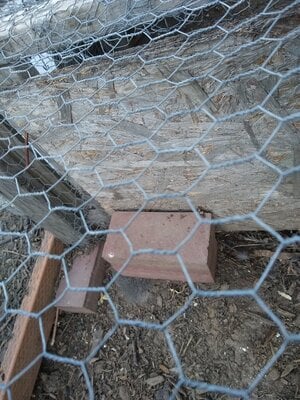
The door that separates the main and private runs.
For more about the private run, explore The Chick Coop!
The pros and cons to having a short, predator-proof run:
Pros
- Material, money, and space conservative.
- Easy to build, and you likely have all the supplies (wood, wire, screws, and a bit of patience).
- Chickens can stretch their wings while being safe from predators.
- If it has lots of support, you can walk on top of the wood frames, not the wire!
- Because I can combine my feeders and waterers, and only have to shut one door at night, it makes less work for me.
- The short height makes it easy to pluck off chickens who are planning a sleepover on top of the run. (read more here: Training Chickens to "Coop" at Night)
Cons
- When there is a sick chicken, stray egg, or something similar in the run, it is a bit hard to get. Sometimes I can maneuver a rake or shovel to retrieve the object but sometimes I have to crawl in.
- Over the years, the amount of poop on the wire ground of the run has built up considerably. Sometime soon I plan to briefly unwire it and shovel the poo out. Wish me luck!
My runs are simple, but ever useful. I think everybody should have one! Best of luck!
P.S. If you want to see more of my builds, check out this link: SoftSilkie's Farmyard
